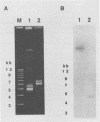Abstract
A protoxin gene, localized to a high-molecular-weight plasmid from Bacillus thuringiensis subsp. kenyae, was cloned on a 19-kb BamHI DNA fragment into Escherichia coli. Characterization of the gene revealed it to be a member of the CryIE toxin subclass which has been reported to be as toxic as the CryIC subclass to larvae from Spodoptera exigua in assays with crude E. coli extracts. To directly test the purified recombinant gene product, the gene was subcloned as a 4.8-kb fragment into an expression vector resulting in the overexpression of a 134-kDa protein in the form of phase-bright inclusions in E. coli. Treatment of solubilized inclusion bodies with either trypsin or gut juice from the silkworm Bombyx mori resulted in the appearance of a protease-resistant 65-kDa protein. In force-feeding bioassays, the purified activated protein was highly toxic to larvae of B. mori but not to larvae of Choristoneura fumiferana. In diet bioassays with larvae from S. exigua, the purified protoxin was nontoxic. However, prior activation of the protoxin by tryptic digestion resulted in the appearance of some toxic activity. These results demonstrate that this new subclass of protein toxin may not be useful for the control of Spodoptera species as previously reported. Hierarchical clustering of the nine known lepidopteran-specific CryI toxin subclasses through multiple sequence alignment suggests that the toxins fall into four possible subgroups or clusters.
Full text
PDF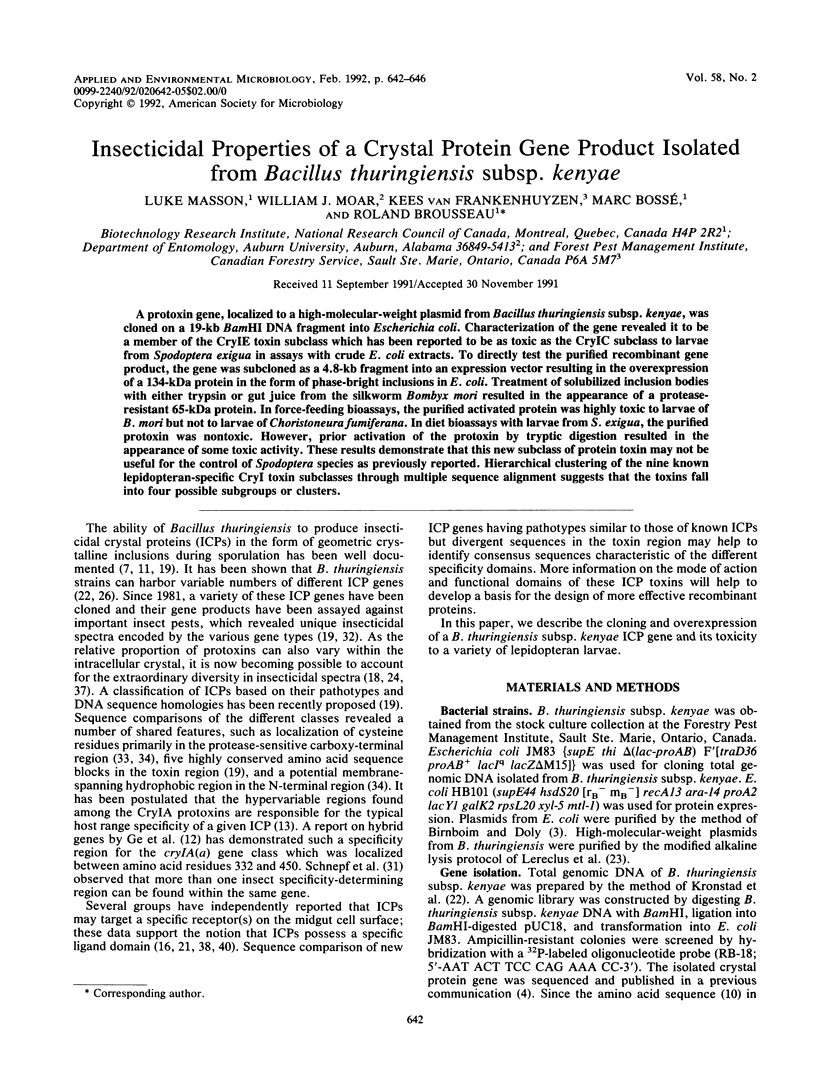
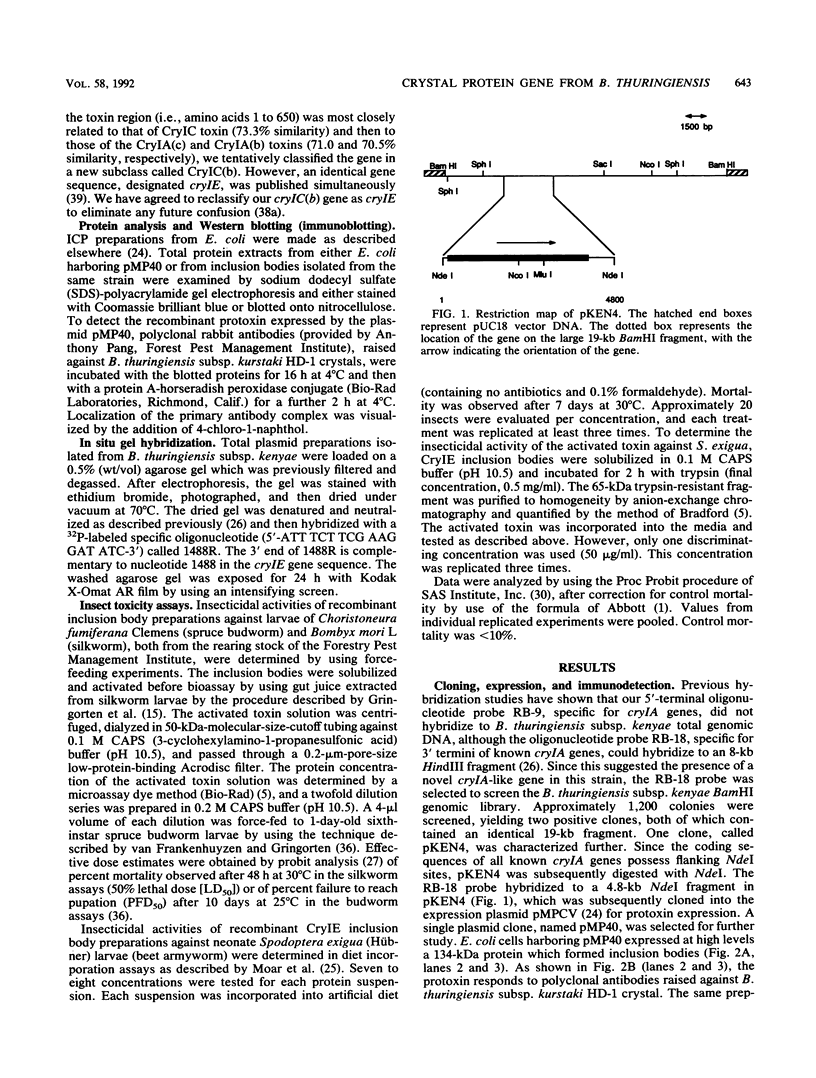
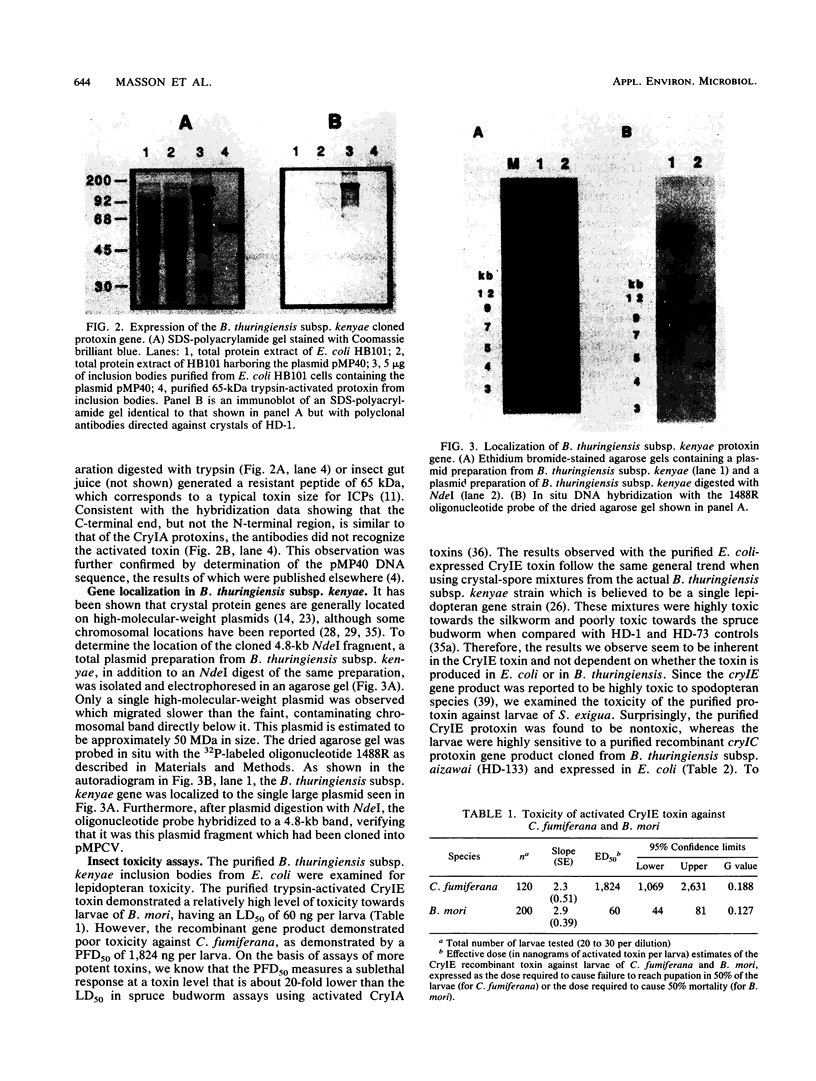
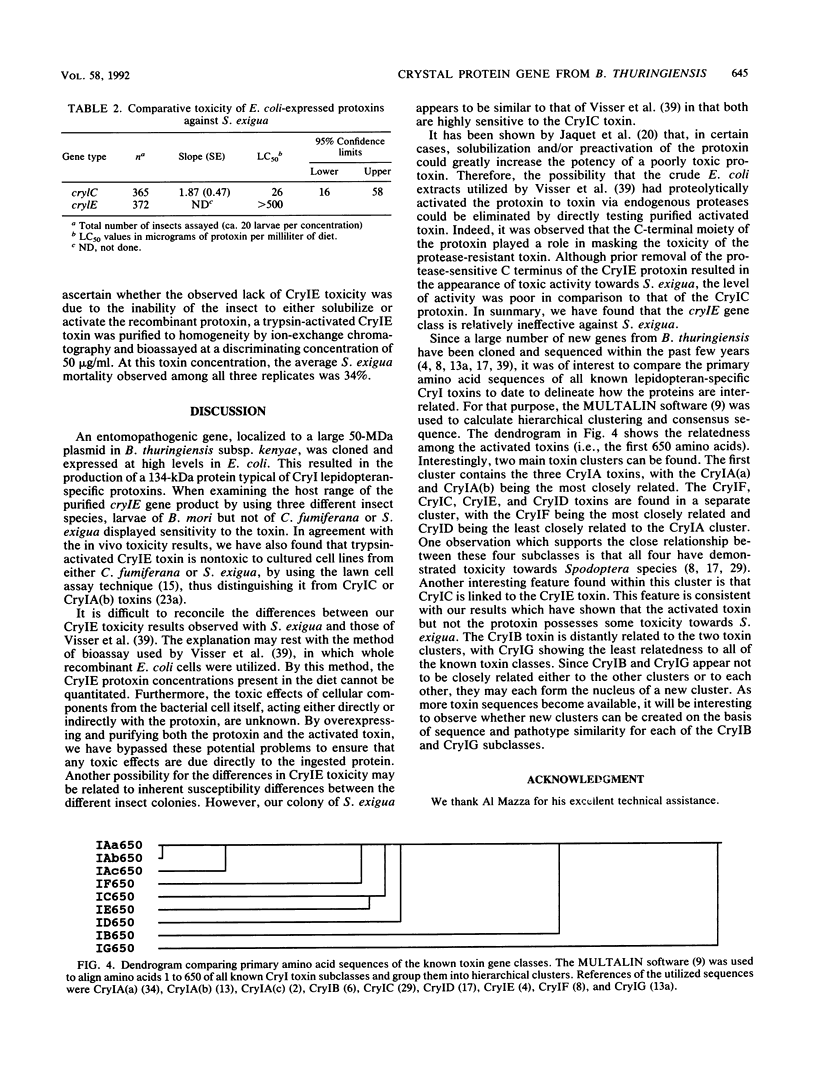
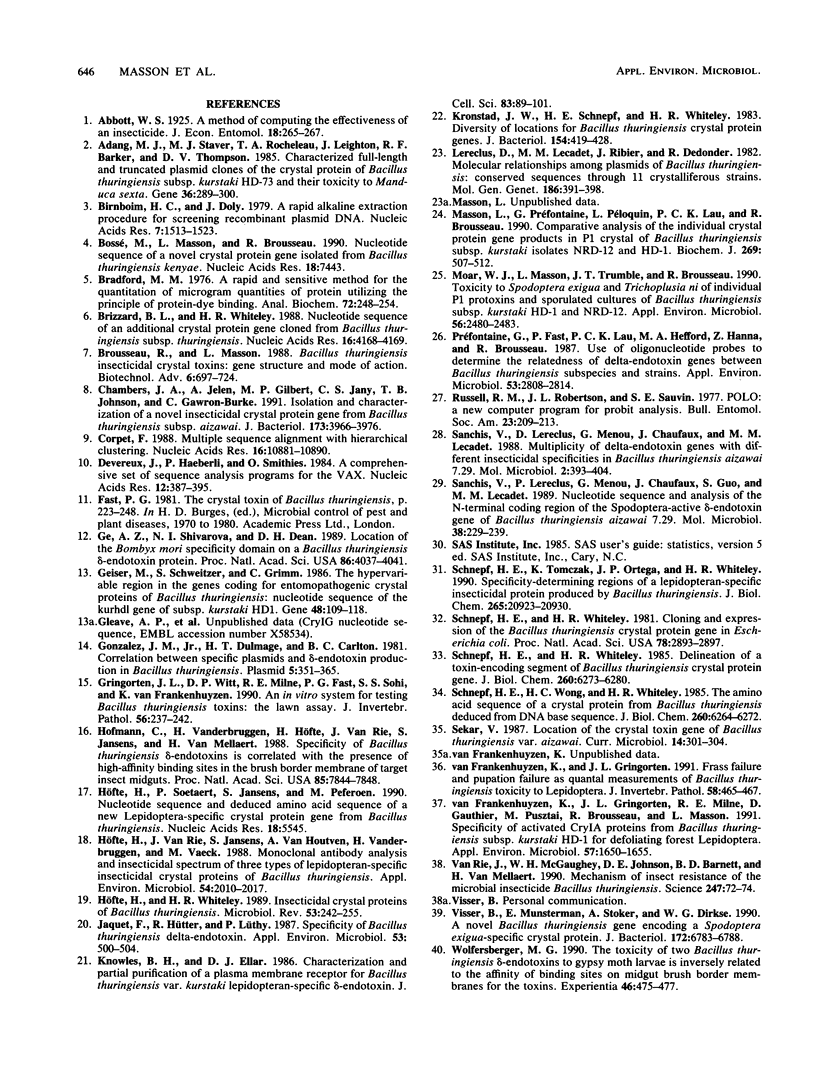
Images in this article
Selected References
These references are in PubMed. This may not be the complete list of references from this article.
- Adang M. J., Staver M. J., Rocheleau T. A., Leighton J., Barker R. F., Thompson D. V. Characterized full-length and truncated plasmid clones of the crystal protein of Bacillus thuringiensis subsp. kurstaki HD-73 and their toxicity to Manduca sexta. Gene. 1985;36(3):289–300. doi: 10.1016/0378-1119(85)90184-2. [DOI] [PubMed] [Google Scholar]
- Birnboim H. C., Doly J. A rapid alkaline extraction procedure for screening recombinant plasmid DNA. Nucleic Acids Res. 1979 Nov 24;7(6):1513–1523. doi: 10.1093/nar/7.6.1513. [DOI] [PMC free article] [PubMed] [Google Scholar]
- Bossé M., Masson L., Brousseau R. Nucleotide sequence of a novel crystal protein gene isolated from Bacillus thuringiensis subspecies kenyae. Nucleic Acids Res. 1990 Dec 25;18(24):7443–7443. doi: 10.1093/nar/18.24.7443. [DOI] [PMC free article] [PubMed] [Google Scholar]
- Bradford M. M. A rapid and sensitive method for the quantitation of microgram quantities of protein utilizing the principle of protein-dye binding. Anal Biochem. 1976 May 7;72:248–254. doi: 10.1006/abio.1976.9999. [DOI] [PubMed] [Google Scholar]
- Brousseau R., Masson L. Bacillus thuringiensis insecticidal crystal toxins: gene structure and mode of action. Biotechnol Adv. 1988;6(4):697–724. doi: 10.1016/0734-9750(88)91920-9. [DOI] [PubMed] [Google Scholar]
- Chambers J. A., Jelen A., Gilbert M. P., Jany C. S., Johnson T. B., Gawron-Burke C. Isolation and characterization of a novel insecticidal crystal protein gene from Bacillus thuringiensis subsp. aizawai. J Bacteriol. 1991 Jul;173(13):3966–3976. doi: 10.1128/jb.173.13.3966-3976.1991. [DOI] [PMC free article] [PubMed] [Google Scholar]
- Corpet F. Multiple sequence alignment with hierarchical clustering. Nucleic Acids Res. 1988 Nov 25;16(22):10881–10890. doi: 10.1093/nar/16.22.10881. [DOI] [PMC free article] [PubMed] [Google Scholar]
- Devereux J., Haeberli P., Smithies O. A comprehensive set of sequence analysis programs for the VAX. Nucleic Acids Res. 1984 Jan 11;12(1 Pt 1):387–395. doi: 10.1093/nar/12.1part1.387. [DOI] [PMC free article] [PubMed] [Google Scholar]
- Ge A. Z., Shivarova N. I., Dean D. H. Location of the Bombyx mori specificity domain on a Bacillus thuringiensis delta-endotoxin protein. Proc Natl Acad Sci U S A. 1989 Jun;86(11):4037–4041. doi: 10.1073/pnas.86.11.4037. [DOI] [PMC free article] [PubMed] [Google Scholar]
- Geiser M., Schweitzer S., Grimm C. The hypervariable region in the genes coding for entomopathogenic crystal proteins of Bacillus thuringiensis: nucleotide sequence of the kurhd1 gene of subsp. kurstaki HD1. Gene. 1986;48(1):109–118. doi: 10.1016/0378-1119(86)90357-4. [DOI] [PubMed] [Google Scholar]
- González J. M., Jr, Dulmage H. T., Carlton B. C. Correlation between specific plasmids and delta-endotoxin production in Bacillus thuringiensis. Plasmid. 1981 May;5(3):352–365. doi: 10.1016/0147-619x(81)90010-x. [DOI] [PubMed] [Google Scholar]
- Gringorten J. L., Witt D. P., Milne R. E., Fast P. G., Sohi S. S., van Frankenhuyzen K. An in vitro system for testing Bacillus thuringiensis toxins: the lawn assay. J Invertebr Pathol. 1990 Sep;56(2):237–242. doi: 10.1016/0022-2011(90)90106-g. [DOI] [PubMed] [Google Scholar]
- Hindley J., Berry C. Bacillus sphaericus strain 2297: nucleotide sequence of 41.9 kDa toxin gene. Nucleic Acids Res. 1988 May 11;16(9):4168–4168. doi: 10.1093/nar/16.9.4168. [DOI] [PMC free article] [PubMed] [Google Scholar]
- Hofmann C., Vanderbruggen H., Höfte H., Van Rie J., Jansens S., Van Mellaert H. Specificity of Bacillus thuringiensis delta-endotoxins is correlated with the presence of high-affinity binding sites in the brush border membrane of target insect midguts. Proc Natl Acad Sci U S A. 1988 Nov;85(21):7844–7848. doi: 10.1073/pnas.85.21.7844. [DOI] [PMC free article] [PubMed] [Google Scholar]
- Höfte H., Soetaert P., Jansens S., Peferoen M. Nucleotide sequence and deduced amino acid sequence of new Lepidoptera-specific crystal protein gene from Bacillus thuringiensis. Nucleic Acids Res. 1990 Sep 25;18(18):5545–5545. doi: 10.1093/nar/18.18.5545. [DOI] [PMC free article] [PubMed] [Google Scholar]
- Höfte H., Van Rie J., Jansens S., Van Houtven A., Vanderbruggen H., Vaeck M. Monoclonal Antibody Analysis and Insecticidal Spectrum of Three Types of Lepidopteran-Specific Insecticidal Crystal Proteins of Bacillus thuringiensis. Appl Environ Microbiol. 1988 Aug;54(8):2010–2017. doi: 10.1128/aem.54.8.2010-2017.1988. [DOI] [PMC free article] [PubMed] [Google Scholar]
- Höfte H., Whiteley H. R. Insecticidal crystal proteins of Bacillus thuringiensis. Microbiol Rev. 1989 Jun;53(2):242–255. doi: 10.1128/mr.53.2.242-255.1989. [DOI] [PMC free article] [PubMed] [Google Scholar]
- Jaquet F., Hütter R., Lüthy P. Specificity of Bacillus thuringiensis Delta-Endotoxin. Appl Environ Microbiol. 1987 Mar;53(3):500–504. doi: 10.1128/aem.53.3.500-504.1987. [DOI] [PMC free article] [PubMed] [Google Scholar]
- Knowles B. H., Ellar D. J. Characterization and partial purification of a plasma membrane receptor for Bacillus thuringiensis var. kurstaki lepidopteran-specific delta-endotoxin. J Cell Sci. 1986 Jul;83:89–101. doi: 10.1242/jcs.83.1.89. [DOI] [PubMed] [Google Scholar]
- Kronstad J. W., Schnepf H. E., Whiteley H. R. Diversity of locations for Bacillus thuringiensis crystal protein genes. J Bacteriol. 1983 Apr;154(1):419–428. doi: 10.1128/jb.154.1.419-428.1983. [DOI] [PMC free article] [PubMed] [Google Scholar]
- Lereclus D., Lecadet M. M., Ribier J., Dedonder R. Molecular relationships among plasmids of Bacillus thuringiensis: conserved sequences through 11 crystalliferous strains. Mol Gen Genet. 1982;186(3):391–398. doi: 10.1007/BF00729459. [DOI] [PubMed] [Google Scholar]
- Masson L., Préfontaine G., Péloquin L., Lau P. C., Brousseau R. Comparative analysis of the individual protoxin components in P1 crystals of Bacillus thuringiensis subsp. kurstaki isolates NRD-12 and HD-1. Biochem J. 1990 Jul 15;269(2):507–512. doi: 10.1042/bj2690507. [DOI] [PMC free article] [PubMed] [Google Scholar]
- Moar W. J., Masson L., Brousseau R., Trumble J. T. Toxicity to Spodoptera exigua and Trichoplusia ni of individual P1 protoxins and sporulated cultures of Bacillus thuringiensis subsp. kurstaki HD-1 and NRD-12. Appl Environ Microbiol. 1990 Aug;56(8):2480–2483. doi: 10.1128/aem.56.8.2480-2483.1990. [DOI] [PMC free article] [PubMed] [Google Scholar]
- Prefontaine G., Fast P., Lau P. C., Hefford M. A., Hanna Z., Brousseau R. Use of oligonucleotide probes to study the relatedness of delta-endotoxin genes among Bacillus thuringiensis subspecies and strains. Appl Environ Microbiol. 1987 Dec;53(12):2808–2814. doi: 10.1128/aem.53.12.2808-2814.1987. [DOI] [PMC free article] [PubMed] [Google Scholar]
- Sanchis V., Lereclus D., Menou G., Chaufaux J., Guo S., Lecadet M. M. Nucleotide sequence and analysis of the N-terminal coding region of the Spodoptera-active delta-endotoxin gene of Bacillus thuringiensis aizawai 7.29. Mol Microbiol. 1989 Feb;3(2):229–238. doi: 10.1111/j.1365-2958.1989.tb01812.x. [DOI] [PubMed] [Google Scholar]
- Sanchis V., Lereclus D., Menou G., Chaufaux J., Lecadet M. M. Multiplicity of delta-endotoxin genes with different insecticidal specificities in Bacillus thuringiensis aizawai 7.29. Mol Microbiol. 1988 May;2(3):393–404. doi: 10.1111/j.1365-2958.1988.tb00044.x. [DOI] [PubMed] [Google Scholar]
- Schnepf H. E., Tomczak K., Ortega J. P., Whiteley H. R. Specificity-determining regions of a lepidopteran-specific insecticidal protein produced by Bacillus thuringiensis. J Biol Chem. 1990 Dec 5;265(34):20923–20930. [PubMed] [Google Scholar]
- Schnepf H. E., Whiteley H. R. Cloning and expression of the Bacillus thuringiensis crystal protein gene in Escherichia coli. Proc Natl Acad Sci U S A. 1981 May;78(5):2893–2897. doi: 10.1073/pnas.78.5.2893. [DOI] [PMC free article] [PubMed] [Google Scholar]
- Schnepf H. E., Whiteley H. R. Delineation of a toxin-encoding segment of a Bacillus thuringiensis crystal protein gene. J Biol Chem. 1985 May 25;260(10):6273–6280. [PubMed] [Google Scholar]
- Schnepf H. E., Wong H. C., Whiteley H. R. The amino acid sequence of a crystal protein from Bacillus thuringiensis deduced from the DNA base sequence. J Biol Chem. 1985 May 25;260(10):6264–6272. [PubMed] [Google Scholar]
- Van Frankenhuyzen K., Gringorten J. L. Frass failure and pupation failure as quantal measurements of Bacillus thuringiensis toxicity to Lepidoptera. J Invertebr Pathol. 1991 Nov;58(3):465–467. doi: 10.1016/0022-2011(91)90199-z. [DOI] [PubMed] [Google Scholar]
- Van Rie J., McGaughey W. H., Johnson D. E., Barnett B. D., Van Mellaert H. Mechanism of insect resistance to the microbial insecticide Bacillus thuringiensis. Science. 1990 Jan 5;247(4938):72–74. doi: 10.1126/science.2294593. [DOI] [PubMed] [Google Scholar]
- Visser B., Munsterman E., Stoker A., Dirkse W. G. A novel Bacillus thuringiensis gene encoding a Spodoptera exigua-specific crystal protein. J Bacteriol. 1990 Dec;172(12):6783–6788. doi: 10.1128/jb.172.12.6783-6788.1990. [DOI] [PMC free article] [PubMed] [Google Scholar]
- Wolfersberger M. G. The toxicity of two Bacillus thuringiensis delta-endotoxins to gypsy moth larvae is inversely related to the affinity of binding sites on midgut brush border membranes for the toxins. Experientia. 1990 May 15;46(5):475–477. doi: 10.1007/BF01954236. [DOI] [PubMed] [Google Scholar]
- van Frankenhuyzen K., Gringorten J. L., Milne R. E., Gauthier D., Pusztai M., Brousseau R., Masson L. Specificity of Activated CryIA Proteins from Bacillus thuringiensis subsp. kurstaki HD-1 for Defoliating Forest Lepidoptera. Appl Environ Microbiol. 1991 Jun;57(6):1650–1655. doi: 10.1128/aem.57.6.1650-1655.1991. [DOI] [PMC free article] [PubMed] [Google Scholar]



